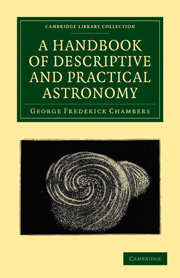Book contents
- Frontmatter
- PREFACE
- SUPPLEMENT
- Contents
- LIST OF ILLUSTRATIONS
- PRINCIPAL AUTHORITIES
- Errata
- A Handbook of Descriptive and Practical Astronomy
- BOOK I A SKETCH OF THE SOLAR SYSTEM
- CHAPTER I THE SUN
- CHAPTER II THE PLANETS
- CHAPTER III VULCAN
- CHAPTER IV MERCURY
- CHAPTER V VENUS
- CHAPTER VI THE EARTH
- CHAPTER VII THE MOON
- CHAPTER VIII MARS
- CHAPTER IX THE MINOR PLANETS
- CHAPTER X JUPITER
- CHAPTER XI SATURN
- CHAPTER XII URANUS
- CHAPTER XIII NEPTUNE
- BOOK II ECLIPSES AND THEIR ASSOCIATED PHENOMENA
- BOOK X METEORIC ASTRONOMY
- APPENDICES
- INDEX TO SUBJECTS
- INDEX TO NAMES
- Plate section
CHAPTER X - JUPITER
Published online by Cambridge University Press: 05 July 2011
- Frontmatter
- PREFACE
- SUPPLEMENT
- Contents
- LIST OF ILLUSTRATIONS
- PRINCIPAL AUTHORITIES
- Errata
- A Handbook of Descriptive and Practical Astronomy
- BOOK I A SKETCH OF THE SOLAR SYSTEM
- CHAPTER I THE SUN
- CHAPTER II THE PLANETS
- CHAPTER III VULCAN
- CHAPTER IV MERCURY
- CHAPTER V VENUS
- CHAPTER VI THE EARTH
- CHAPTER VII THE MOON
- CHAPTER VIII MARS
- CHAPTER IX THE MINOR PLANETS
- CHAPTER X JUPITER
- CHAPTER XI SATURN
- CHAPTER XII URANUS
- CHAPTER XIII NEPTUNE
- BOOK II ECLIPSES AND THEIR ASSOCIATED PHENOMENA
- BOOK X METEORIC ASTRONOMY
- APPENDICES
- INDEX TO SUBJECTS
- INDEX TO NAMES
- Plate section
Summary
Jupiter is the largest planet of the system, and when in and near opposition shines with a brilliancy inferior only to Venus. A friend of the writer has informed him that on October 16, 1857, the planet's lustre was so considerable as to throw a sensible shadow. When telescopically examined, the surface of Jupiter is found to be marked with a series of dusky streaks, commonly known as the “ belts.” These belts vary greatly in form, size, and number from time to time. Occasionally only two or three broad ones are seen, at other times as many as eight, ten, or even a dozen narrow ones. Their physical nature is not well understood, but they are usually considered to be masses of cloud, acted upon in a manner in some way analogous to our terrestrial trade-winds, If this is the true hypothesis, as probably it is, then the planet has wind, rain, water and clouds, and is consequently fitted for the existence of animal and vegetable life. The existence of the belts was first detected by Zuppi, at Naples, in May 1730, though a claim has been put in on behalf of Torricelli.
- Type
- Chapter
- Information
- A Handbook of Descriptive and Practical Astronomy , pp. 59 - 64Publisher: Cambridge University PressPrint publication year: 2010First published in: 1861

